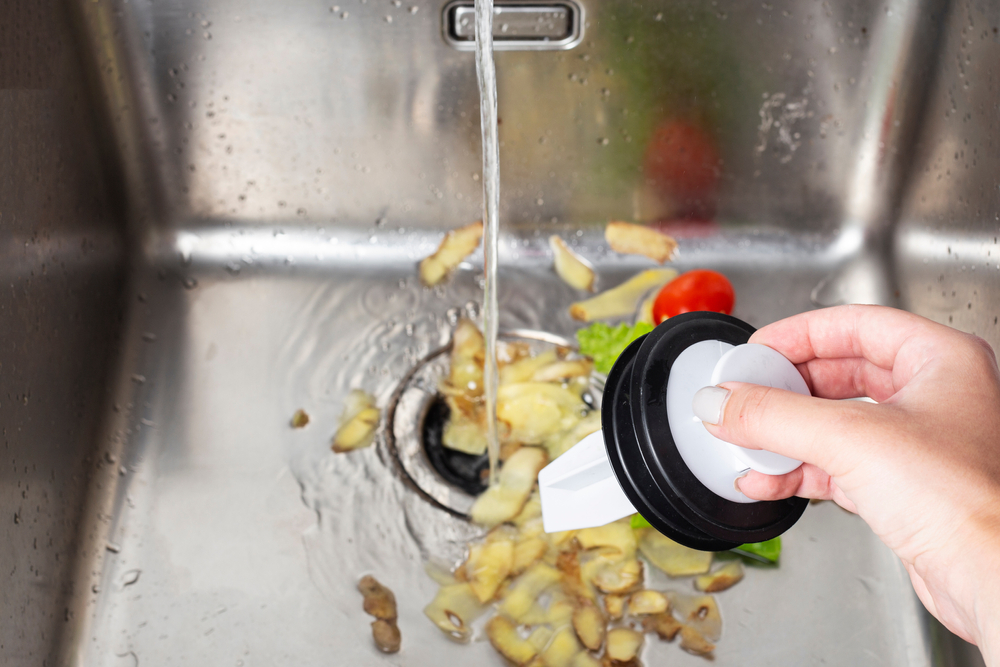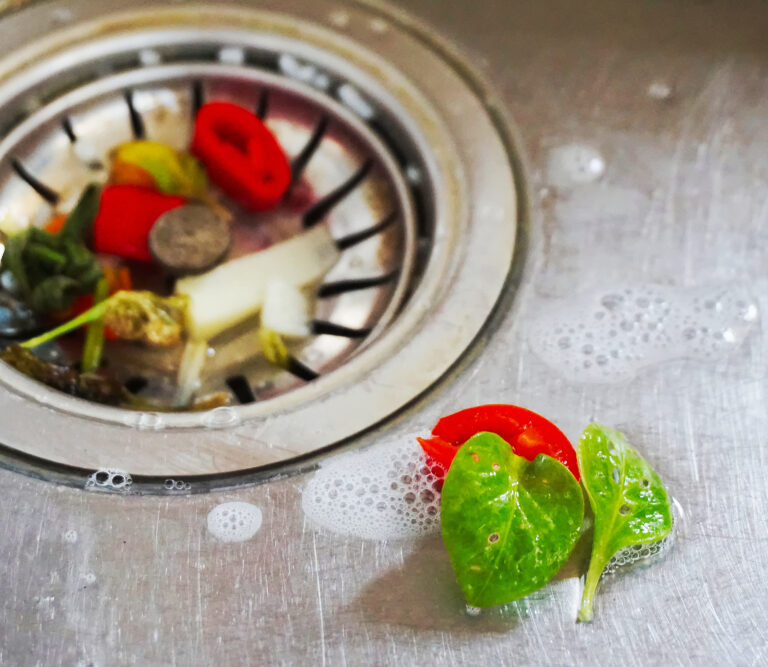Your garbage disposal does a dirty job, and if you don’t clean it regularly, everybody in the house will be able to tell just how dirty this job is. It’s perfectly normal for a disposal to become dirty (and smelly) from time to time, but getting into a regular cleaning habit can help you avoid an unpleasant smell and potentially prevent plumbing issues down the road.
Below, we cover the five best cleaning methods for garbage disposals. Experiment with a few cleaning methods until you find one that works — and clean the disposal regularly to keep it clear and in good working order. You probably have the items you need to clean the disposal on hand already. Follow these steps to clean your garbage disposal.
Before You Start – Cut the Power
Before you try any of these cleaning methods, make sure the disposal will have no chance of engaging while your hands are near the blades. Either unplug it or, if that’s not possible, turn off the circuit from the electrical panel. Some disposals are wired to the same circuit as kitchen lighting, so make sure to grab a flashlight.
Take your flashlight and point it down into the sink drain to expose the area of the disposal blades. If your sink is smelly but it’s draining well, that often means there’s a rotting piece of food (yep, that’s gross) stuck in the disposal.
If you find an obstruction, use a pair of long pliers to reach in and grab it (again, make sure the disposal does not have power).
How to Clean a Garbage Disposal: The Top 5 Methods
Once your power is off, you’re ready to get started cleaning with one of the methods below.
1. Scrub the Baffle & Chamber
If there’s nothing trapped in the disposal or the drain, chances are the baffle and/or disposal chamber need a good scrubbing. The disposal baffle is the rubber flap that separates the sink from the disposal itself, creating a splash guard.
As food waste that’s put down into the disposal is macerated when you run the disposal, particles splash up onto the baffle, but if you don’t regularly clean it, those particles will begin to rot and develop bacteria, which is what creates that familiar smell. Similarly, areas around the top of the disposal chamber can become coated in food particles that build up and begin to smell.
- Take an abrasive kitchen sponge, scrubber brush, or an old toothbrush loaded up with warm water and soap and scrub the top and underside of the baffle, rinsing as often as you need to remove grime from the sponge or brush.
- Then reach in and use the sponge or brush to clear the top edge of the grinding chamber, which is directly on the underside of the sink.
- Swipe your sponge or brush as often as it takes around the circular area to remove the crime, again rinsing as you go.
Doing this about once per week can help ensure grime doesn’t build up on the baffle and grinding chamber, but if your disposal still smells, there are a few more techniques for eliminating the excess food particles that can create a stench.
2. The Ice Technique
The theory of the ice technique is that the disposal griding ice will create tiny shards that can scrape away stuck food particles, as well as potentially helping sharpen the disposal blades and keeping them in good working order.
- With the disposal connected to power but switched off, put about a dozen ice cubes in the disposal.
- Turn on the water in a medium, cold stream and then run the disposal for about a minute or until the disposal has cleared all the ice.
- Turn the disposal off and keep the water running for about 30 seconds after that.
3. The Ice, Salt & Lemon Technique
The ice technique is helpful for clearing stubborn food particles from the disposal blades as well as sharpening them, but it’s possible for smells to remain even after the disposal has been cleaned. If this is your issue, try adding a few extra items to the ice technique like lemon and salt.
- With this method, you still fill the disposal with ice, but this time, you add a few lemon wedges and about one cup of coarse salt, like rock or sea salt.
- Turn on a medium stream of cold water, and then flip the disposal on.
If things go as they should, the ice and salt will scrub the blades and clear them of any pesky grime, while the lemon will freshen the air. This technique also works by substituting the salt and lemon for vinegar, though the result may not be as pleasing to the senses.
4. The Baking Soda & Vinegar Technique
The brief chemical reaction between baking soda and vinegar can help break up stubborn food particles in the chamber, though it’s unlikely to help clear a clog (if that’s an issue) because of the nature of the chemical reaction.
- With the disposal off, pour one cup of vinegar into the disposal, followed by a slowly poured half-cup of baking soda.
- Plug the sink drain with the stopper, as the mixture will begin to fizz and expand. Putting the stopper in the drain helps keep the beneficial fizzing inside the disposal chamber.
- Once the fizzing has stopped, run a medium stream of cold water into the sink and engage the disposal for a few seconds.
5. The Flushing Technique
This can help clear out any final food particles by forcing a large amount of water through the pipes at once — flushing, in other words.
- With the disposal off, plug the sink drain with the stopper.
- Till the sink about three-quarters full of cold water, adding a bit of dish soap.
- Remove the drain plug and immediately turn on the disposal.
- Allow the disposal to run while all the water runs out.
Garbage Disposal Cleaning & Maintenance Tips

Once you’ve managed to get your garbage disposal to cease putting off a foul stench (which is probably caused by bacteria — ew), regular cleaning and maintenance of the disposal and some smart garbage disposal practices can help keep the disposal clean.
Establish a Routine
Cleaning your garbage disposal at least a couple of times per month and ideally once a week is the best way to prevent food particle buildup and make the disposal easier to clean. Regardless of which of the methods listed above (or a combination of multiple techniques) works for you, cleaning should become part of your overall housekeeping routine.
If you’re prone to things like this slipping your mind, connect it to some other event that occurs once a week or once every couple of weeks, like changing your bed sheets, to remind yourself.
Be Careful About What You Put Down There
Not every bit of leftovers should go down your sink, and things like grease and coffee grounds should be avoided.
In fact, you should put as little into the disposal as possible, but it’s particularly important to avoid fibrous vegetables like celery. When they’re broken down, these can create strings that easily become trapped in a disposal’s grinder mechanism.
Foods that are high in starch, such as potatoes or potato skins, should never go into your disposal, as the starch can clog up the gears of the disposal.
A removable strainer for the sink drain can help catch fine particles that you can then put in the trash (or onto a compost pile, depending on what’s in it). Remember that this item, particularly if it’s made of rubber, silicone, or another non-metal material, will also need to be cleaned regularly since it’s coming into constant contact with food particles.
Use the Disposal Regularly
Running the disposal at least once every couple of days helps keep rust and corrosion from building up on the mechanisms, and when you’re using it to grind food waste, maintain a medium flow of cold water. Keep that water flowing for about 15 seconds after you shut the disposal off.
Avoid Hot Water
Putting overly hot water down your sink can cause any grease or fat that’s in the drain to liquefy, which may make it stick to other portions of the sink, or even the disposal blades; this is true when the disposal is off or on.
Never Use Your Fingers to Clear Jams
If you do notice that something has become stuck in the disposal, cut the power, and look inside using a flashlight. Only clear clogs using long pliers or tongs to pull the material free. Even with the disposal off, you can cut your fingers by placing them near the blades.
In the event that a piece of food waste, like a fiber from an onion skin, becomes trapped in the disposal blade, use the wrench that came with the disposal.
Avoid Harsh Drain Cleaners
Even if your sink becomes clogged, drains that have garbage disposals aren’t good options for commercial clog removers. Unless you can be sure that you’ll be able to fully flush the drain-cleaning product, which is really not possible in a garbage disposal because you can’t visualize the drain, it’s easy for even a few drops of the liquid to remain in the sink and splatter out the next time you turn the disposal on.
Besides, the methods we described above will work just as well without the harsh chemicals.
Try a Disposal Freshener
If you’d rather use an all-in-one garbage disposal cleaning product, consider a disposal cleaner, which generally includes a cleanser like baking soda, and a freshener like citric acid. A variety of scents are available, such as lemon or orange.
Clean Your Garbage Disposal Like a Pro
Dealing with a garbage disposal mess or odor may seem daunting, but the methods we covered are simple, effective, and stress-free. Keep our tips in mind to avoid major messes, and if one does occur, trust that these methods can help force grime, residue, and odors down the drain.
